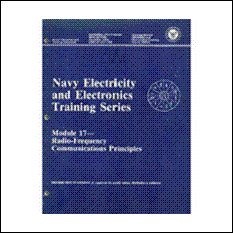Microwaves
MICROWAVES or radio frequencies (RF) are that portion of the electromagnetic spectrum which falls between 1000 megahertz and 100,000 megahertz.
Before discussing the principles and applications of these frequencies, the meaning as it is used in this tutorial must be established.
On the surface, the definition would appear to be simple because, in electronics, the prefix "micro" normally means a millionth part of a unit. Micro also means small, which is a relative term, and it is used in that sense in this tutorial.
Microwave is a term loosely applied to identify electromagnetic waves above 1000 megahertz in frequency because of the short physical wavelengths of these frequencies. Short wavelength energy offers distinct advantages in many applications.
For instance, excellent directivity can be obtained using relatively small antennas and low-power transmitters. These features are ideal for use in both military and civilian radar and communication applications. Small antennas and other small components are made possible by rf frequency applications.
This is an important consideration in marine equipment planning where space and weight are major problems. RF frequency usage is especially important in the design of marine radar because it makes possible the detection of smaller targets.
RF frequencies present special problems in transmission, generation, and circuit design that are not encountered at lower frequencies. Conventional circuit theory is based on voltages and currents while RF theory is based on electromagnetic fields.
The concept of electromagnetic field interaction is not entirely new, since electromagnetic fields form the basis of all antenna theory. However, many students of electronics find electromagnetic field theory very difficult to visualize and understand.
These tutorials will present the principles of RF theory in the simplest terms possible but many of the concepts are still somewhat difficult to thoroughly understand. Therefore, you must realize that this tutorial will require very careful study for you to properly understand RF theory.
Antenna fundamentals were covered in a previous tutorial. This tutorial will show you the solutions to problems encountered at RF frequencies, beginning with the transmission of RF energy and continuing through to waveguides.
Subsequent tutorials will cover the theory of operation of RF components, circuits, and antennas. The application of these concepts will be discussed more thoroughly in later tutorials on radar and communications.
Microwaves-components
Velocity modulation
RF tubes, the basic two-cavity klystron and the multi-cavity power klystron
The Reflex klystron
The decibel measurement system
The traveling wavetube and the backward-wave oscillator
The Magnetron and basic operation
Magnetron operation cont.- and negative resistance
Electron-resonance-magnetron and electrical equivelant
The Electric field
Coupling-method and magnetron tuning
Arcing-in-magnetrons, the crossed-field-amplifier (Amplitron), and solid state microwave devices
Tunnel-diode-devices, oscillators, amplifiers, frequency converters, and mixers
Varactor-devices and the parametric amplifier
Varactor devices continued
Bulk-effect-semiconductors, transferred-electron semiconductors, and avalanche transit-time diodes
Point-contact-diode, Schottky diodes, and the Pin diode















